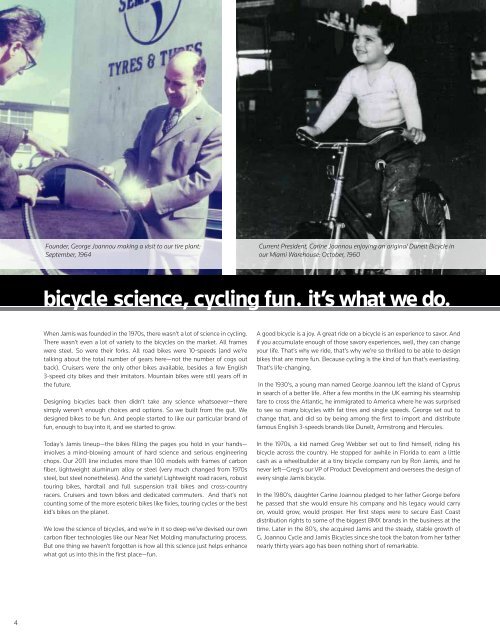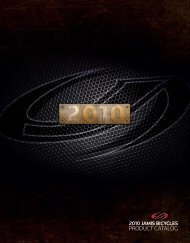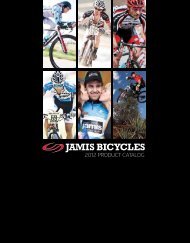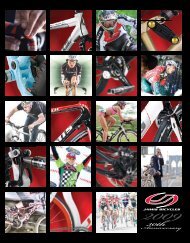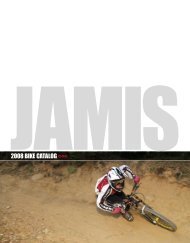You also want an ePaper? Increase the reach of your titles
YUMPU automatically turns print PDFs into web optimized ePapers that Google loves.
Founder, George Joannou making a visit to our tire plant:September, 1964Current President, Carine Joannou enjoying an original Dunelt Bicycle inour Miami Warehouse: October, 1960Current VP of Product Development, Greg Webber pedaling ita few thousand miles to the west coast: July, 1976Carine Joannou and Greg Webber today. Nothing motivates thesetwo more than the idea that a bicycle has the power to positivelychange lives and the world.bicycle science, cycling fun. it’s what we do.When <strong>Jamis</strong> was founded in the 1970s, there wasn’t a lot of science in cycling.There wasn’t even a lot of variety to the bicycles on the market. All frameswere steel. So were their forks. All road bikes were 10-speeds (and we’retalking about the total number of gears here—not the number of cogs outback). Cruisers were the only other bikes available, besides a few English3-speed city bikes and their imitators. Mountain bikes were still years off inthe future.Designing bicycles back then didn’t take any science whatsoever—theresimply weren’t enough choices and options. So we built from the gut. Wedesigned bikes to be fun. And people started to like our particular brand offun, enough to buy into it, and we started to grow.Today’s <strong>Jamis</strong> lineup—the bikes filling the pages you hold in your hands—involves a mind-blowing amount of hard science and serious engineeringchops. Our <strong>2011</strong> line includes more than 100 models with frames of carbonfiber, lightweight aluminum alloy or steel (very much changed from 1970ssteel, but steel nonetheless). And the variety! Lightweight road racers, robusttouring bikes, hardtail and full suspension trail bikes and cross-countryracers. Cruisers and town bikes and dedicated commuters. And that’s notcounting some of the more esoteric bikes like fixies, touring cycles or the bestkid’s bikes on the planet.We love the science of bicycles, and we’re in it so deep we’ve devised our owncarbon fiber technologies like our Near Net Molding manufacturing process.But one thing we haven’t forgotten is how all this science just helps enhancewhat got us into this in the first place—fun.A good bicycle is a joy. A great ride on a bicycle is an experience to savor. Andif you accumulate enough of those savory experiences, well, they can changeyour life. That’s why we ride, that’s why we’re so thrilled to be able to designbikes that are more fun. Because cycling is the kind of fun that’s everlasting.That’s life-changing.In the 1930’s, a young man named George Joannou left the island of Cyprusin search of a better life. After a few months in the UK earning his steamshipfare to cross the Atlantic, he immigrated to America where he was surprisedto see so many bicycles with fat tires and single speeds. George set out tochange that, and did so by being among the first to import and distributefamous English 3-speeds brands like Dunelt, Armstrong and Hercules.In the 1970s, a kid named Greg Webber set out to find himself, riding hisbicycle across the country. He stopped for awhile in Florida to earn a littlecash as a wheelbuilder at a tiny bicycle company run by Ron <strong>Jamis</strong>, and henever left—Greg’s our VP of Product Development and oversees the design ofevery single <strong>Jamis</strong> bicycle.In the 1980’s, daughter Carine Joannou pledged to her father George beforehe passed that she would ensure his company and his legacy would carryon, would grow, would prosper. Her first steps were to secure East Coastdistribution rights to some of the biggest BMX brands in the business at thetime. Later in the 80’s, she acquired <strong>Jamis</strong> and the steady, stable growth ofG. Joannou Cycle and <strong>Jamis</strong> <strong>Bicycles</strong> since she took the baton from her fathernearly thirty years ago has been nothing short of remarkable.So we’re keenly aware of the transformative power of the bicycle. We’vewitnessed it firsthand. We’ve lived it. Are living it. And it’s why we’re committedto so many cycling categories—this is our opportunity to reach as many soulsas possible.Transformation is exactly what’s happening in cycling today, on so manylevels. Bicycle commuting is up in cities all over the country. People havebeen inspired to get off their couches and tackle a century ride, or take multidaycycling trips courtesy of philanthropic fundraisers like the Leukemia andLymphoma Society’s Team in Training and the AIDS Ride. Schoolyard bikeracks are crowded again, as kids discover the mobility and fun of fixies, toohipcruisers and city bikes. <strong>Bicycles</strong> are enjoying newfound popularity oncollege campuses and local bike paths.And the bikes themselves are changing, in ways we’d never imagined. Ourstate-of-the-art road line, Xenith, uses super-high modulus carbon fiber sorefined you would’ve had to be a defense contractor to procure some just a fewyears ago. And it’s available with electronically actuated shifting, somethingwe’d never have imagined in the recent past, and it still drops our jaws as weexperience shifting perfection at the push of a button. Every time.On the mountain bike side, we’ve never had such a wealth of top-levelchoices. Carbon chassis hardtail cross-country conquerors like our DakotadXC, or carbon full-suspension XC racers like the Dakota XCR. All-mountainmachines like Dakar XCT. Big-wheel bikes like Dragon 29 and Dakota d29, orthe full-suspension, 650b-shod Sixfifty. Not to mention long-travel hardtailslike Komodo, and our new-for-<strong>2011</strong>, better-than-ever mp4 suspension design.And then there are our fitness bikes, purpose-built commuters and touringbikes. Our fixed gear urban rockets, Sputnik and Beatnik; and fast city haulerslike Commuter and Allegro. Not to mention long-day road bikes like Enduraand Ventura.We tune and refine relentlessly. Every single platform. Every frame. Every size.There’s a lot of science involved in bringing this huge variety of bikes to fruition,to see them through from pencil sketch to computer monitor to productionreality. It takes serious work to give each of them a distinct personality thatbalances a focused sense of purpose with the versatility to be more than justa one-trick pony. And with the number of late nights and double espressos weburn through to make it all happen it’s easy to get caught up in the minutiaeof carbon fiber lay-ups, heat-treated aluminum alloys, shifter technologiesand tire compounds and gearing strategies. And while we’ll freely admit toloving this aspect of bicycle design, so much so that we’ll talk it up for hours,proudly pointing out slick technical aspects of our bikes at bike rallies, tradeshows and, yes, even this catalog—we haven’t forgotten why we got so heavilyinto the science in the first place.It’s all about the fun. It’s about making bicycles more accessible, moreaffordable and more capable. Because that’s what makes cycling one of life’sfiner addictions—being able to take yourself places with a minimum of effort,powered by legs and lungs, driven by little more than the desire and thewillingness to turn those pedals over.Ultimately, we know the bicycle is simply a vehicle, a means of getting youfrom one place to another. But we also know there’s more to it, that a bicyclecan move you to another place—spiritually, emotionally and physically. That’sthe true power of the bicycle. And that’s why we’re proud to keep making ourbikes better, more capable, and more fun than ever before.This is our high water mark. There’s never been a better, more capable crop ofnew <strong>Jamis</strong> bicycles, with more depth and variety. And, we hope, there’s one inthe lot that speaks to you, and your particular brand of fun.4 5


